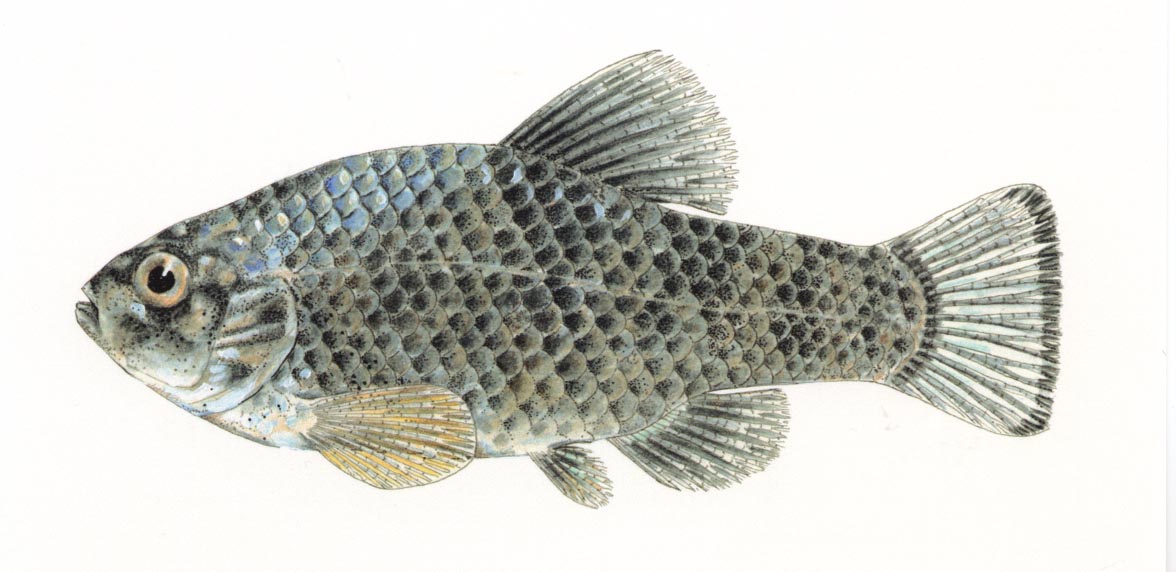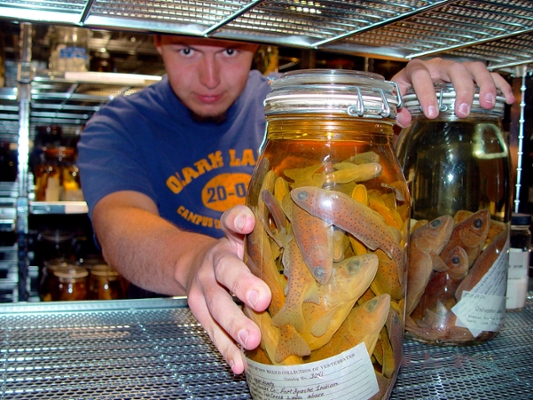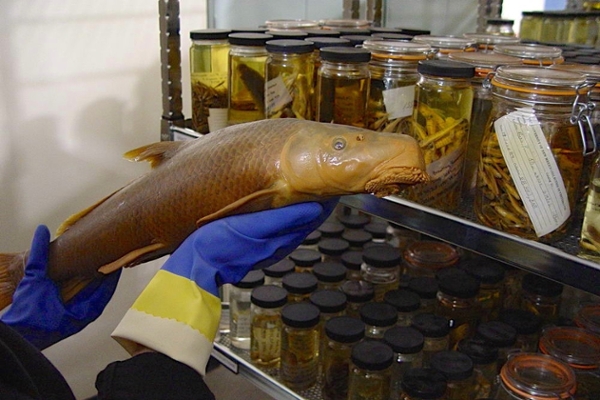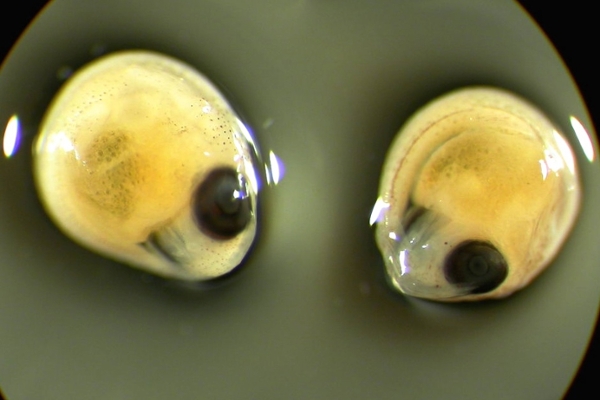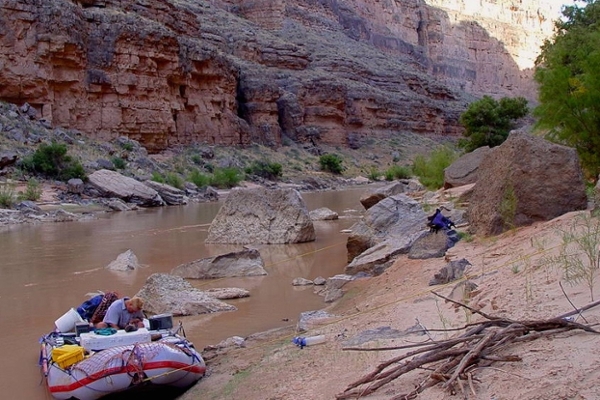Welcome to the Division of Fishes
Our Mission and Goals
MSB Division of Fishes was founded to document ichthyofaunal history of the State of New Mexico and the American Southwest. Today, this remains our primary mission. We strive to build and maintain these collections of fishes and supporting documents by using sound curatorial techniques and archiving these collections in optimal storage conditions. It is our hope that by using the best curatorial practices and materials available that we will ensure the long-term conservation of these collections and they will be available to future generations of ichthyologists and other members of the scientific community. As a university research collection, we encourage and foster UNM student and faculty research in ichthyology and/or museum studies; provide assistance to other researchers interested in the ecology of New Mexico fishes and fishes of the southwestern U.S.; provide information on New Mexico fishes to the general public.
The Division of Fishes serves a region in North America noted for a wide range of ecotypes and elevational gradients, from the Rocky Mountains to the Great Basin and the Great Plains, with the convergence of three major deserts, the Chihuahua, Sonora, and Mojave. The fish fauna of New Mexico (and the southwestern US) is characterized by high endemism, diversity, and remarkable physiological tolerances.
These collections are particularly valuable because aquatic habitats in the region are declining as demands on water increase due to human population growth and global climate changes. The MSB collection of fishes provides a 70-year window on the natural history of New Mexico's imperiled native fishes and aquatic systems. The MSB has over 96,000 cataloged lots of fishes (4,153,582 specimens), representing 63 families, 178 genera, and 420 species, collected between 1938 and present day.
MSB fish records, available on FishNet2, include all holdings except for fishes collected on private and Tribal lands. MSB fish specimens consist of mostly cypriniform larval and adult fishes (vouchers and tissues), conserved, across taxa, in 5% buffered formalin, 70% and 95% ethanol, and frozen at -20°C and -80°C to maintain good examples for morphological, osteological, and genetic research. The MSB Division of Fishes does not hold holotypes and divides collections of paratypes with other permanent fish collections. Over 60,000 pages of field books and field data forms are archived in the Division. These documents are digitally captured and electronically archived in tiff files (permanent) and clean PDF files for viewing. The original field documents are maintained in acid and lignin free boxes for permanent storage. For access to and use of fish specimens, original records, and documentation, please see collection use policy.
History of the Fishes Collections
William J. Koster (1910-1993) came to New Mexico in 1938 after receiving his Ph.D. in zoology from Cornell University. He became the University of New Mexico’s first instructor of vertebrate zoology. In this capacity, he and his students collected New Mexico vertebrates for study in the labs and classes. In recognition of the unique fauna represented in these teaching collections, Koster began to document and catalog the specimens. Please go to LoboVault to view W.J. Koster’s field notes and specimen records.
Once the Department of Biology hired curators for the Divisions of Mammals, and Amphibians and Reptiles, Koster was able to devote more time to his research on the life histories of some New Mexico fishes while expanding the collection’s holdings. He also completed a layperson’s Guide to the Fishes of New Mexico in 1959 and had hoped to follow this with a more technical volume on the ichthyofauna of New Mexico. Unfortunately, a serious accident in 1960 dramatically curtailed his ability to perform field work for the rest of his career. By the time William J. Koster retired in 1975, the “UNM Collection of Vertebrates” had grown and collectively became the Museum of Southwestern Biology.
In 1975, Manuel C. Molles, Ph.D. University of Arizona, Tucson joined the UNM Department of Biology and assumed the duties of curator of fishes. His research included reef fishes, aquatic invertebrate community structure, and changes in global climate. Dr. Molles served as curator of fishes until 1998 when he became MSB Curator of Arthropods and Director of the museum.
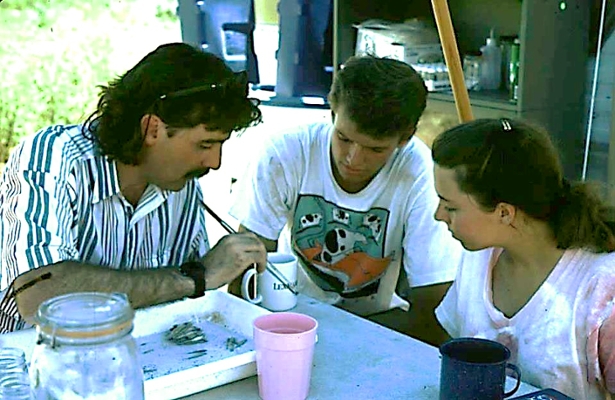
In 1986, Steven P. Platania came to New Mexico to study the distribution of native New Mexico fishes and assumed curatorial duties as an Associate Curator in the MSB Division of Fishes. He established an Ichthyofaunal Studies Program, which continues today, employing students in both the museum and biological fields. Under his direction, the collection underwent a phase of rapid growth. It has served as the primary repository for not only his collections, but also large collections received from the New Mexico Department of Game and Fish, the U.S. Fish and Wildlife Service Fisheries Resource Office in Albuquerque, the U.S. Bureau of Land Management, and the U.S. Bureau of Reclamation.
In 1992, Platania hired a full-time Collections Manager, Alexandra M. Snyder, to keep pace with the increasing curatorial demands and to establish a protocol for the care and maintenance of the fish specimens and documentation. By 1995, the collection was fully captured in an electronic catalog and orphaned collections (1989-1992) from the San Juan River Restoration Implementation Program, received. Prior to moving the fish collections to a renovated facility (2001), the physical condition of the specimen collections was upgraded with new, archival quality jars, gaskets, caps, and stainless steel tanks. After the move, the following large and important collections were received and fully integrated (specimens and data) by 2013: the New Mexico State Reference Collections of Fishes, New Mexico Fish and Wildlife Conservation Office collections of fishes from the Pecos River, and the Biological Survey Collections from the USGS office in Fort Collins, CO.
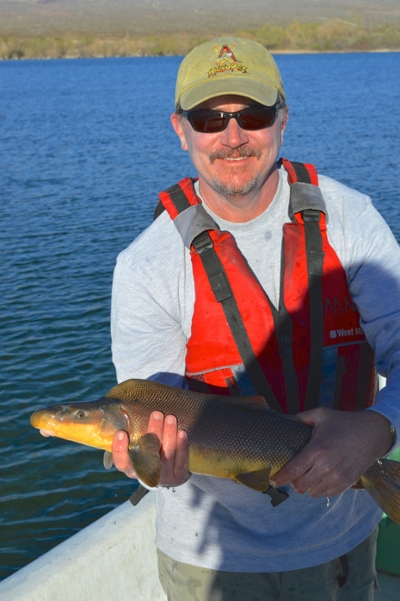
Thomas F. Turner assumed the position of Curator of Fishes in 1998 and the collection entered a new phase of growth in terms of its genomic holdings for rare and extirpated species like the Rio Grande silvery minnow and the Gila trout. Turner has focused his research on the fishes of the American southwest, studying the ecological and biogeographic determinants of population structure and the molecular systematics of these fishes. Through these research activities, Turner and his graduate students are able to add more to the information on the conservation biology of desert fishes.
In January 2001, the MSB Division of Fishes moved to a newly renovated building across from the Department of Biology's Castetter Hall. By the time the collections were moved, the jars of MSB fishes greatly exceeded the stationary shelving space available in the old basement facility (84.5m2) of UNM Biology’s Castetter Hall. Approximately 30% of the cataloged lots of fishes were stored in boxes and HD plastic 8- and 15-gallon barrels. The new facility provides 473m2 of space for fluid preserved specimens, all on mobile shelving units (compactors) and maintained at a constant temperature of 18°C and in complete dark when not in use.
Future research on fishes of New Mexico will be linked more than ever to the issues of the dwindling water resources in the State. The collections and data will always serve to document the history of New Mexico’s water systems and availability of water for fishes and consequently, humans.
Platania, S.P. 1997. The building of the University of New Mexico fish collection: case study of a small university collection. In Collection Building in Ichthyology and Herpetology, T.W. Pietsch and W.D. Anderson, Eds. ASIH
Platania, S.P. 1993. William J. Koster, 13 March 1910-22 Feb 1993. Copeia (3):925-27


